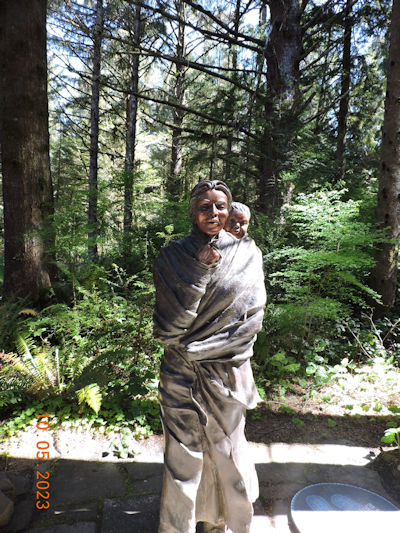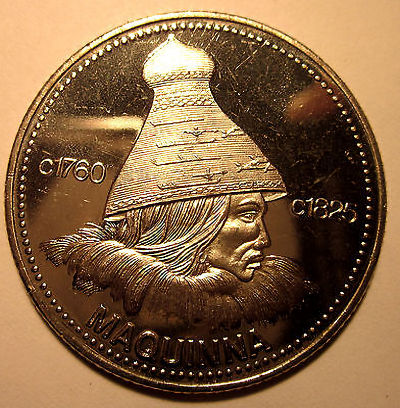| North in the Spring #28: Non-Indigenous History of the West Coast
by John Neville  Excluding the many people who already lived on the coast, the colonial countries started to seriously explore and chart the northwest coast in the 18th century: to find a northwest passage, to gain political control and for economic gains. Half a millennia ago Juan de Fuca, Sir Francis Drake and possibly a Chinese fleet came this way, but the details are lost in the mists of time.
Excluding the many people who already lived on the coast, the colonial countries started to seriously explore and chart the northwest coast in the 18th century: to find a northwest passage, to gain political control and for economic gains. Half a millennia ago Juan de Fuca, Sir Francis Drake and possibly a Chinese fleet came this way, but the details are lost in the mists of time.
To understand the Russian involvement we have to go back to Peter the Great. Russia was considered backward and only had one sea port on the White Sea. Peter expanded Russia to the Black Sea and established St Petersberg in 1703, on the Baltic Sea. Peter wanted Russia to adopt a western culture, technology, education, ship-building and off course access to the Pacific. A statue in St Petersberg shows him riding on a magnificent rearing horse, making a huge leap symbolically towards the west. His first Kamchatka expedition was only a partial success. Peter died of a urinary infection and did not witness it's end. The second expedition was approved by Empress Anna in 1733. She was a relative of Peter and wished to fulfill his ambitions. The Vitus Bering party would have to cross 1/3 of the globe, 9650 km from St Petersberg to Kamchatka, contending with a hostile climate, no roads and no supplies available en route. Even today its hard to imagine moving 3000 or more people such a great distance with all their equipment, and many of them not returning to St Petersberg for ten years. The ships St Peter and St Paul were launched in 1741 and sailed for America in June. On July 16th they saw "A range of snow dusted spires, draped in fog. Among them, a high volcano." It was St Elias Day and they named the peak accordingly. Its one of the highest mountains in Canada or the US at 5489 m. This mountain range is easy to see from the Alaska Hwy in the Yukon. We are reminded of this exploration by the critters named after the German naturalist on board. Steller's Sea Cow (related to the Manatee and Dugong), were quickly hunted to extinction. Steller's Jay and Steller's Sea lion are much better known and perpetuate his name. Some of the other animals he described were: The Fur Seal, Sea Otter, Steller's Eider and the Blue Fox. Georg Steller was also the first to recognize the 5 species of anadromous Pacific salmon: in translation they became Chinook, Sockeye, Coho, Pink and Chum Salmon. In 1778 Captain James Cook spent most of April at Nootka Sound, halfway up the west coast of Vancouver Island. Chief Maquinna of the Nuu-chah-nulth People of Nootka Sound welcomed him. Today they are called Mowachaht People and live at Gold River. He needed to replace the fore and mizzenmast of his ships and found the local Douglas Fir to be very serviceable. The fir from BC was soon competing in Royal Navy shipyards with fir from Latvia. His collection of 1500 Sea Otter pelts quickly jump started the marine fur trade. The crew were able to brew spruce beer which Cook knew warded off scurvy. Cook also established longitude while at Nootka, which he called Friendly Cove. At that time, Short-tailed Albatross were common on the Pacific coast, and their bones appear regularly in First Nation middens. These magnificent birds, with their 2.26 m wing span were still common when Scouler sailed up the coast in the William and Ann in 1824. Many of the common birds that were seen by the Cook expedition were recorded in paintings and are still housed in the British Natural History Museum. At the northern most point of Cook's incredible voyage, he named the western entrance to the Arctic Ocean Bering's Strait. Archibald Menzies first visited Nootka Sound in 1787 with Captain Colnett. He botanized with two female relatives of Chief Maquinna in the nearby forest. Menzies returned to Britain 1789 with a collection of plants and seeds. He again visited the west coast with Captain George Vancouver and met Chief Maquinna's sister-in-law again. One of the honours attached to Menzies is the Latin name for the Arbutus, Arbutus Menziesii. He was the first European to describe: Skunk, Sandhill Crane, Bald Eagle, Rhinoceros Auklet, Cutthroat trout, Purple Rhododendron, Dogwoods and much more fauna and flora. In 1788, John Meares was one of several British and American captains to visit the west coast in search of the valuable Sea Otters. His name lives on at Meares Island, where a reservoir provides fresh water for Tofino. He also became embroiled with the Spanish resulting in the Convention (Treaties) of Nootka Sound. In 1791, a Spanish expedition from Nootka entered Juan de Fuca Strait and named Haro Strait, San Juan and Saturna Islands.  Captain George Vancouver had been a midshipman on Cook’s visit to Nootka Sound. He returned in 1792, 93 and 94 looking for the fabled Northwest Passage. Ironically, melting of the Arctic ice, due to global warming, may soon create the Northwest Passage. He was able to chart much of the West Coast. Puget Sound, Mount Baker and Georgia Strait are just a few of his named places. He met with and shared his charts with Captain Galiano in 1792. The charts of Galiano, Valdez, and Gabriola Islands show some of Galiano's achievements. He made another footnote in history, when he died in the Spanish cause at the battle of Trafalgar.
Captain George Vancouver had been a midshipman on Cook’s visit to Nootka Sound. He returned in 1792, 93 and 94 looking for the fabled Northwest Passage. Ironically, melting of the Arctic ice, due to global warming, may soon create the Northwest Passage. He was able to chart much of the West Coast. Puget Sound, Mount Baker and Georgia Strait are just a few of his named places. He met with and shared his charts with Captain Galiano in 1792. The charts of Galiano, Valdez, and Gabriola Islands show some of Galiano's achievements. He made another footnote in history, when he died in the Spanish cause at the battle of Trafalgar.
Mackenzie reached the coast at Bella Bella: "Alexander Mackenzie overland from Canada, July 22nd, 1793." is written on the rocks. His route up the Peace River established the first colonial settlements in BC beginning with Fort St John, 1794. At the beginning of the nineteenth century President Thomas Jefferson read the journals of Mackenzie. Like Britain, Spain and Russia, the US was also very interested in the West Coast. Jefferson quickly organized four expeditions to explore the newly acquired Louisiana Purchase. Lewis and Clark were put in charge of the Core of Discovery to find a route across the western mountains to the West Coast. One of the special people on this journey was Sacagawea, a Lemhi Shoshone woman, carrying her baby on her back. Her presence in the bow of the lead canoe indicated the Core's peaceful intent when entering new first nation territories. They reached the coast in November 1805 near present day Astoria. The Lewis and Clark National Park is a great place to learn about the Core and it's accomplishments. One of the documentary films is made from the perspective of the Chinook People, and the misfortunes that befell them in the early colonial era. After David Thompson travelled down the Columbia River in 1811, the Hudson Bay Company set-up their headquarters at Fort Vancouver in Washington territory. The first place to use Vancouver's name. In 1824, a HBC supply ship, The William and Ann deposited David Douglas at the headquarters. His name is on many plants including the Douglas Fir. He botanized extensively through this region and travelled across Canada with the HBC. Anticipating the establishment of the international boundary, the HBC moved it's headquarters in 1843, to Fort Victoria. The establishment of the province of British Columbia had begun! Our colonial society has led to many negative changes on the coast. Bering's expedition quickly caused the extinction of the Steller's Sea Cow. The explorers and traders caused the extirpation of BC’s Sea Otters and the decline of many Kelp beds. The Core of Discovery shot California Condors in the Columbia Valley leading to their extirpation. Wholesale whaling and logging followed. The genetically distinct “Wholly Dogs” of the Coast Salish People became extinct in the late 19th century. They had been domesticated for about 5.000 years and were genetically distinct from all other dogs. Their wool was harvested each fall and woven into ceremonial cloaks and other garments. The one remaining pelt is housed in the Smithsonian Natural History Museum. As over fishing of Herring and Salmon has multiplied, the Orca's have become the Southern Occasional Resident Killer Whales! The federal Department of Fisheries and Oceans, DFO, is failing partly because of its conflicting responsibilities: 1. to protect the fish and marine life 2. to manage and control the fishing fleet. In addition we are flooding the ocean with plastics, chemicals and noise pollution. Stephen Hawking said, "We are in danger of destroying ourselves by our greed and stupidity." However, there is some hope: our colonial society is starting to listen and understand our First Nations approach to nature. We are also learning from science. Recently, there has been a significant return of Gray and Hump-backed Whales! About 11 years ago, BC Nature led a court battle which stopped the Northern Gateway Pipeline project. The Wuikinuxv, Heiltsuk, Nuxalk, Kitasoo Xai'xais, Gitga'at, Gitxaala Nations, CPAWS, West Coast Environmental Law, have proposed a large Central Coast National Marine Conservation Area Reserve, called The Great Bear Sea. The Province is preparing a Coastal Marine Strategy to protect some elements of our future. The draft Strategy is right now being circulated with First Nations. We can all help by supporting and giving positive criticism to these plans! |